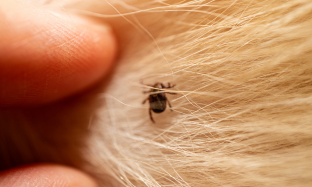
How to remove a tick on my dog/cat?
Ticks that cling to the skin of pets to suck their blood are particularly numerous from April to September. Infestation peaks may vary following climates, for example in spring and summer in more Southern climates. The more dogs and cats spend time outdoors, the more cautious you must be as there parasites can transmit serious diseases to pets.
When fasting, a tick measures 3 to 10mm; it is therefore visible to the naked eye. After a blood meal, it can reach more than once centimeter! If you spot a tick on your pet, it is imperative to remove it quickly.
Know where to look for ticks
Before their blood meal, ticks often go unnoticed in thick-coated animals. So it's useful to know where to look for them first. Theoretically, a tick can get fixed anywhere, but in dogs and cats, they are most likely to be found on the head, the neck and the chest.
A study performed on a large number of dogs has shown that ticks are found on the head level in about of cases. Of those on the head, 25% are around the eyes, 24% in the ears and 15% close to the muzzle. Otherwise, ticks are found mainly on the limbs (12% of cases), on the neck (9%) and on the chest (8%)*. In cats, 43% of ticks are attached to the head, 32% to the neck, 20% to the cheeks, and 9% close to the muzzle*.
Always have a "tick-removal" tool at your disposal!
Don't try to crush the tick or pull it off with tweezers: the rostrum (the anterior part of the tick attached to the skin) breaks very easily and an inflammation or an abscess might develop if it stays in place.
There are specific hooks that allow a tick to be removes without breaking the rostrum. This type of tool is designed to wedge the tick between the branches and remove it with a rotating motion, without leaving the rostrum in place. The tick falls down after 2 to 3 turns. This limits the risk of abscess and inoculation of diseases vectors. As a precaution, disinfect the area where the tick was attached.
Be careful to crush the ticks you remove: if you just throw them on the ground, they could re-infest your pet later!
If your pet is very much exposed to ticks, regular applications of a tick repellent control is strongly advised: your veterinarian will tell you which product to choose, according to your pet's way of life. But even if your dog/cat wears a tick collar or receives a repellent regularly, this should not prevent you from carefully checking it when coming back from a walk!
**Do not use ether or turpentine to kill a tick. These products can facilitate the regurgitation of saliva in the skin of dogs or cats, which promotes the transmission of pathogen agents.**
*Sources:
Wright I, et. al. Be tick aware: when and where to check cats and dogs for ticks, Veterinary Record, 2018, http://dx.doi.org/10.1136/vr.104649
NSW Government: Department of Primary Industries: Paralysis-Ticks and Cattle: https://www.dpi.nsw.gov.au/__data/assets/pdf_file/0013/160321/Paralysis-Ticks.pdf

